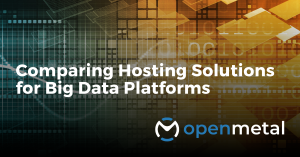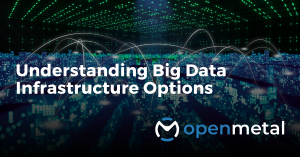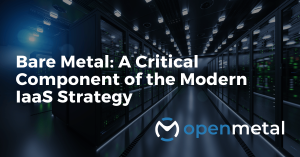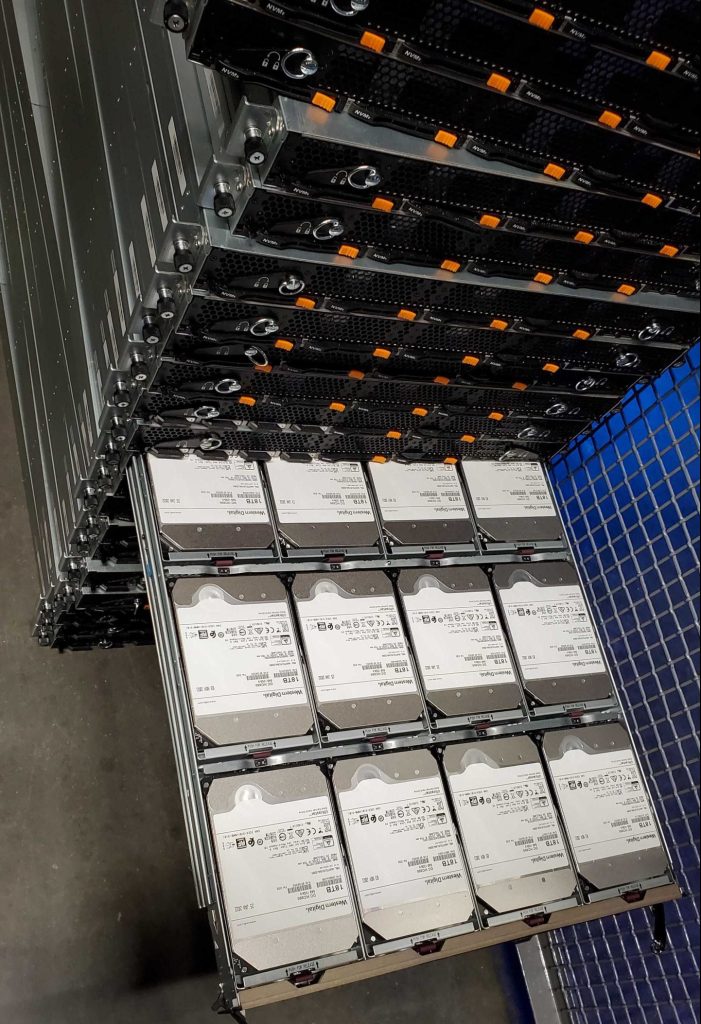Big Data Needs Big Infrastructure
They say a building is only as good as the foundation that it is built on. The same can be said about big data and the infrastructure on which it runs. Learn how the infrastructure can affect the performance of big data processing.
Importance of Big Data IT Infrastructure
Learn how infrastructure can affect the performance of big data platforms.
Comparing Big Data Infrastructure Options
Learn about the different options for supporting big data platforms.
Benefits of Big Data Platforms on OpenMetal
Learn how (and which) big data platforms can benefit.
For a detailed discussion and assessment of your big data needs, schedule a complimentary cloud consultation.
Defining Big Data
To understand how we support big data, let’s first define the big data references used on these pages to avoid any confusion.
- Big Data: This refers to “data sets too large or complex to be dealt with by traditional data-processing application software.”
- Big Data Platforms: These are systems that use software and hardware to process and aggregate data on a massive scale.
- Big Data Infrastructure: This refers to underlying bare metal infrastructure that hosts big data platforms and delivers operational resources such as compute, storage, connectivity, etc.
The Importance of the Big Data IT Infrastructure
To drive large volumes of data storing, processing, and analyzing, big data platforms require a strong IT or cloud infrastructure that can be configured with these platforms and have the operational power to:
- Collect high volumes of data quickly
- Handle large amounts of disk and network I/O
- Deliver highly available systems, including rapid recovery capabilities
- Enable scalability of machines for increasing storage and/or compute power
To ensure the highest levels of speed, reliability, and performance, the underlying infrastructure needs to provide optimal resources for:
Compute
Big data often requires robust compute resources that can do the heavy lifting necessary to perform parallel processing. The stronger the compute resources, the stronger the horsepower that drives the speed, efficiency, and performance of processing that creates the actionable insights from big data.
Storage
One of the biggest considerations for big data is storage scalability. As the volume of data grows, the infrastructure must be able to quickly and seamlessly expand to accommodate. This requires distributed and cloud storage solutions that can scale horizontally by adding more servers or storage clusters if and when needed.
Connectivity
To share or transfer big data between various sources and destinations, you need high-quality networks. This is critical as the value of big data platforms is to quickly create and share real-time insights. If data is delayed by even seconds, it can have a significantly negative impact on decisions made with that data.
The underlying infrastructure and its resource capabilities are critical to the performance of the big data platforms. But beyond the operational aspects of the hardware infrastructure, the type of cloud or infrastructure you use to host these platforms offers significant differences.
Comparing Infrastructure Options
Infrastructure options to host big data platforms typically include public clouds, private clouds, and on-premises environments. When considering the most appropriate platform for hosting big data platforms, it is important to understand how each option can support or affect user control, security measures, scalability, and cost-efficiency.
User Controls
User control over the big data infrastructure gives IT teams the ability to customize operations for optimal performance, scalability, security, and data protection.
| Public Cloud | Traditional Private Cloud | On-Premises |
|---|---|---|
|
|
|
Security
The right security measures can enable the power and potential of big data platforms while keeping user data and information protected from harm.
| Public Cloud | Traditional Private Cloud | On-Premises |
|---|---|---|
|
|
|
Scalability
Scalability is a critical component of accommodating and processing the increasing volumes of data for big data platforms, to deliver real-time sight for data driven teams.
| Public Cloud | Traditional Private Cloud | On-Premises |
|---|---|---|
|
|
|
Upfront and Ongoing Costs
Appropriate big data infrastructures can come at a cost. Therefore, it is important to use the infrastructure as effectively and efficiently as possible to drive greater big data platforms success.
| Public Cloud | Traditional Private Cloud | On-Premises |
|---|---|---|
|
|
|
Each option offers pros and cons. Traditional private clouds are a powerful option to manage large amounts of data. But, while they offer more control, security, and cost-efficiency benefits, it requires time and financial commitments that many businesses may not be willing to risk.
Benefits of Big Data Platforms on OpenMetal
OpenMetal offers the benefits of private cloud and/or on-premises environments with the speed, convenience, and lowered commitment risk of public cloud options, making it a strong infrastructure option to support big data platforms.
Using an on-demand, hosted private cloud infrastructure, OpenMetal delivers unique benefits for big data platforms, including many of the most popular platforms that OpenMetal has already validated for optimal performance.
What are the Key Benefits that Makes OpenMetal Ideal for Big Data Platforms?
A Powerful Cloud Core from the Start
OpenMetal Clouds start with a single-tenant Cloud Core of three bare metal dedicated servers with built-in resources, such as compute, Ceph storage, and certain allocations of egress included, right out of the box. Resources can then be scaled up from here.
Rapid Deployment and Scalability
OpenMetal Clouds can be deployed in 45 seconds, used, destroyed, and spun up again as needed. While you are assigned dedicated servers, it is still a cloud-native environment that allows you to build, scale, and spin up or down easily from an OpenMetal User Portal.
Control Without the Management
OpenMetal Clouds allow full access to root server configurations for customization and optimization of performance. The physical servers, however, are still managed by OpenMetal to remove the common burdens associated with hardware management.
Security
OpenMetal Clouds offer all of the inherent security and control benefits of private cloud and on-premise environments, with the added physical access security protection offered by Tier III data centers that offer multiple compliance and sustainability certifications.
Reduced Costs
OpenMetal Clouds can help reduce traditional cloud costs 50% by avoiding upfront spends, removing licensing costs, and lowering egress costs. The largest cost efficiencies, however, are enabled by the ability to optimize operational performance and maximize use of the entire pool of resources.
Open Source
OpenMetal Clouds are built on and powered by the open source, OpenStack platform. This not only alleviates common proprietary licensing costs and technology vendor lock-in concerns, it allows for easier integration with a vast pool of open source technologies, including many of the big data platforms.
Looking for More Info on Big Data?
If you would like more information on big data infrastructure with OpenMetal, we recommend that you visit some of these featured articles and resources:







































